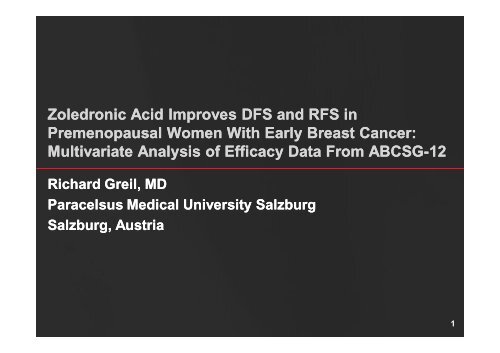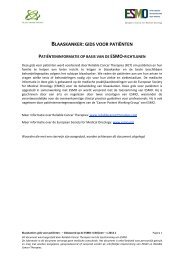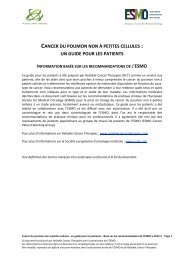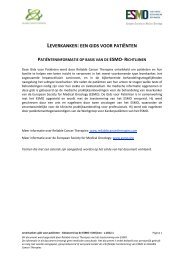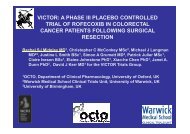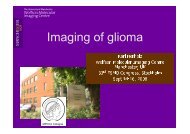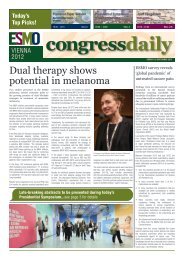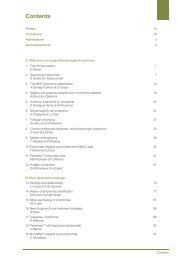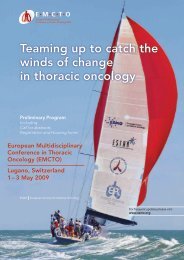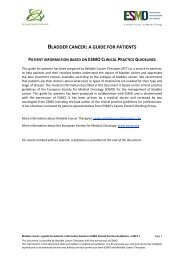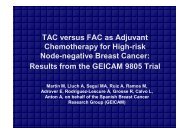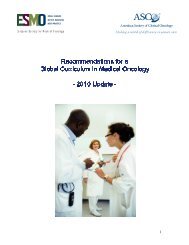Dr Gnant - ESMO Oral Presentation 08
Dr Gnant - ESMO Oral Presentation 08
Dr Gnant - ESMO Oral Presentation 08
You also want an ePaper? Increase the reach of your titles
YUMPU automatically turns print PDFs into web optimized ePapers that Google loves.
Zoledronic Acid Improves DFS and RFS in<br />
Premenopausal Women With Early Breast Cancer:<br />
Multivariate Analysis of Efficacy Data From ABCSG-12<br />
Richard Greil, MD<br />
Paracelsus Medical University Salzburg<br />
Salzburg, Austria<br />
1
Questions to Be Answered<br />
• When based on a Goserelin backbone, can<br />
aromatase inhibitors improve clinical outcome<br />
compared with tamoxifen?<br />
• Can bisphosphonates added to endocrine<br />
therapy further improve outcome?<br />
2
Rationale for Investigating AIs for Premenopausal<br />
Endocrine-Responsive Breast Cancer<br />
• Aromatase inhibitors (AIs) have superior efficacy<br />
compared with tamoxifen for postmenopausal<br />
endocrine-responsive breast cancer 1-7<br />
– Significantly prolong disease-free survival (DFS)<br />
– Significantly reduce distant recurrence<br />
• ANA plus goserelin significantly reduced mean<br />
estrogen levels in premenopausal women who<br />
experienced disease progression during treatment<br />
with goserelin plus TAM (P < .0001) 8<br />
– TAM + goserelin reduced estrogen by 89%<br />
– ANA + goserelin further reduced estrogen by an additional 76%<br />
ANA = Anastrozole; TAM = Tamoxifen.<br />
1. Howell A, et al. Lancet. 2005;365:60-62; 2. Thurlimann B, et al. N Engl J Med. 2005;353:2747-2757; 3. Coates A, et al. J Clin<br />
Oncol. 2007;25:486-492; 4. Coombes RC, et al. N Engl J Med. 2004;350:1<strong>08</strong>1-1092; 5. Coombes RC, et al. Lancet.<br />
2007;369:559-570; 6. Jakesz R, et al. Lancet. 2005;366:455-462; 7. Goss P, et al. J Natl Cancer Inst. 2005;97:1262-1271;<br />
8. Forward DP, et al. Br J Cancer. 2004;90:590-594.<br />
3
Zoledronic Acid Can Inhibit the Process of<br />
Metastasis at Several Key Steps<br />
Primary tumor<br />
Synergy with<br />
anticancer drugs<br />
Inhibits<br />
angiogenesis<br />
Angiogenesis<br />
Metastases Micrometastases<br />
Adhesion &<br />
extravasation<br />
Adapted from Mundy GR, et al. Nature Reviews Cancer. 2002;2:584-593.<br />
Direct antitumor effect Indirect antitumor effect<br />
Induces<br />
tumor cell<br />
apoptosis<br />
Stimulates immune<br />
surveillance<br />
Invasion<br />
Decreases<br />
matrix invasion<br />
Decreases<br />
adhesion to bone<br />
Arrest in distant<br />
capillary<br />
4
ABCSG-12 Trial Design<br />
• Accrual 1999-2006<br />
• 1,803 premenopausal breast cancer pts<br />
• Endocrine-responsive (ER + and/or PgR + )<br />
• Stage I and II, < 10 positive nodes<br />
• No chemotherapy except neoadjuvant<br />
• Treatment duration: 3 years<br />
Surgery<br />
(+ RT)<br />
Goserelin<br />
3.6 mg q 28 d<br />
DFS = Disease-free survival; RFS = Relapse-free survival;<br />
OS = Overall survival; BMFS = Bone metastasis-free survival;<br />
TAM = Tamoxifen; ANA = Anastrozole; ZOL = Zoledronic acid.<br />
Randomize<br />
1 : 1 : 1: 1<br />
2 Key Comparisons:<br />
TAM vs ANA<br />
ZOL vs no ZOL<br />
TAM 20 mg/d<br />
TAM 20 mg/d<br />
+ ZOL 4 mg q 6 mo<br />
ANA 1 mg/d<br />
ANA 1 mg/d<br />
+ ZOL 4 mg q 6 mo<br />
5
Study Endpoints (TAM vs ANA; ZOL vs No ZOL)<br />
• Primary endpoint<br />
– Disease-free survival (DFS)<br />
– DFS events: local recurrence, contralateral breast cancer,<br />
distant metastasis, secondary carcinoma, death<br />
• Secondary endpoints<br />
– Recurrence-free survival (RFS): local recurrence,<br />
contralateral breast cancer, distant metastasis,<br />
secondary carcinoma<br />
– Overall survival<br />
– Safety<br />
• Exploratory endpoint<br />
– Bone-metastases–free survival<br />
6
Baseline Demographics and<br />
Disease Characteristics<br />
n, (%)<br />
TAM<br />
(n = 451)<br />
TAM + ZOL<br />
(n = 449)<br />
ANA<br />
(n = 453)<br />
ANA + ZOL<br />
(n = 450)<br />
Median age, years 45.5 45.3 45.0 44.5<br />
≥ T1<br />
T2<br />
338 (75.1) 335 (74.6) 348 (77.0) 339 (75.5)<br />
99 (22.0) 98 (21.8) 93 (20.6) 97 (21.6)<br />
Node negative 301 (66.9) 295 (65.7) 303 (67.0) 302 (67.3)<br />
Node positive 136 (30.2) 138 (30.7) 139 (30.8) 135 (30.1)<br />
ER + / 2+ 217 (48.1) 210 (46.8) 221 (48.8) 211 (46.9)<br />
ER 3+ 204 (45.2) 204 (45.4) 206 (45.5) 210 (46.7)<br />
PgR + / 2+ 212 (47.0) 206 (45.9) 217 (47.9) 190 (42.2)<br />
PgR 3+ 185 (41.0) 195 (43.4) 200 (44.2) 212 (47.1)<br />
Histologic Grade 3 93 (20.7) 89 (19.0) 97 (21.5) 98 (21.0)<br />
Neoadj. Chemo 24 (5.3) 23 (5.1) 24 (5.3) 26 (5.8)<br />
TAM = Tamoxifen; ZOL = Zoledronic acid; ANA = Anastrozole; ER = Estrogen receptor; PgR = Progesterone receptor.<br />
Update of <strong>Gnant</strong> M, et al. Presented at: ASCO 20<strong>08</strong>. Chicago, IL. Abstract LBA4.<br />
7
Trial Status<br />
• 1,803 patients recruited from 1999 to 2006<br />
– Baseline demographics and disease characteristics well<br />
balanced between study arms<br />
• Median follow-up: 48 months<br />
• 137 first DFS events, 42 deaths recorded<br />
– 30 locoregional relapse events<br />
– 70 distant relapse events<br />
• 39 bone metastasis events<br />
– 16 contralateral breast cancer events<br />
– 19 new nonbreast primaries<br />
• Overall: 4-year DFS = 92.4%; 4-year OS = 97.7%<br />
8
ANA Does Not Improve DFS vs TAM<br />
Disease-free survival, %<br />
No. at risk<br />
TAM<br />
ANA<br />
100<br />
90<br />
80<br />
70<br />
60<br />
50<br />
40<br />
30<br />
20<br />
10<br />
No. of Hazard ratio (95% CI)<br />
events vs TAM P value<br />
ANA 72 1.096 (0.78 to 1.53) .593<br />
TAM 65<br />
0 0 12 24 36 48 60 72 84<br />
Time since randomization, months<br />
900 834 718 552 411 243 129 50<br />
903 844 725 540 411 255 139 51<br />
Median follow-up = 48 months.<br />
DFS = Disease-free survival; CI = Confidence interval; ZOL = Zoledronic acid.<br />
Update of <strong>Gnant</strong> M, et al. Presented at: ASCO 20<strong>08</strong>. Chicago, IL. Abstract LBA4.<br />
9
ZOL Significantly Improves DFS Compared<br />
With Endocrine Therapy Alone<br />
Disease-free survival, %<br />
100<br />
90<br />
80<br />
70<br />
60<br />
50<br />
40<br />
30<br />
20<br />
10<br />
0<br />
No. of Hazard ratio (95% CI)<br />
events vs No ZOL P value<br />
ZOL 54 0.643 (0.46, 0.91) .012<br />
No ZOL 83<br />
0 12 24 36 48 60 72 84<br />
Time since randomization, months<br />
No. at risk<br />
No ZOL 904 832 713 537 407 241 145 47<br />
ZOL 899 846 730 555 414 257 123 54<br />
Median follow-up = 48 months.<br />
DFS = Disease-free survival; CI = Confidence interval; ZOL = Zoledronic acid.<br />
Update of <strong>Gnant</strong> M, et al. Presented at: ASCO 20<strong>08</strong>. Chicago, IL. Abstract LBA4.<br />
10
ZOL Significantly Improves RFS Compared<br />
With Endocrine Therapy Alone<br />
Recurrence-free survival, %<br />
100<br />
90<br />
80<br />
70<br />
60<br />
50<br />
40<br />
30<br />
20<br />
10<br />
0<br />
No. of Hazard ratio (95% CI)<br />
events vs No ZOL P value<br />
ZOL 54 0.653 (0.46, 0.92) .014<br />
No ZOL 82<br />
0 12 24 36 48 60 72 84<br />
Time since randomization, months<br />
No. at risk<br />
No ZOL 904 832 713 537 407 241 145 47<br />
ZOL 899 846 730 555 414 257 123 54<br />
Median follow-up = 48 months.<br />
RFS = Recurrence-free survival; CI = Confidence interval; ZOL = Zoledronic acid.<br />
Update of <strong>Gnant</strong> M, et al. Presented at: ASCO 20<strong>08</strong>. Chicago, IL. Abstract LBA4.<br />
11
ZOL-Treated Patients Showed a<br />
Nonsignificant Trend Toward Improved OS<br />
Overall survival, %<br />
100<br />
90<br />
80<br />
70<br />
60<br />
50<br />
40<br />
30<br />
20<br />
10<br />
0<br />
No. of Hazard ratio (95% CI)<br />
events vs No ZOL P value<br />
ZOL 16 0.595 (0.32, 1.11) .101<br />
No ZOL 26<br />
0 12 24 36 48 60 72 84<br />
Time since randomization, months<br />
No. at risk<br />
No ZOL 904 838 735 565 441 265 161 60<br />
ZOL 899 851 744 573 434 270 131 59<br />
Median follow-up = 48 months.<br />
OS = Overall survival; CI = Confidence interval; ZOL = Zoledronic acid.<br />
Update of <strong>Gnant</strong> M, et al. Presented at: ASCO 20<strong>08</strong>. Chicago, IL. Abstract LBA4.<br />
12
Incidence of Bone Metastases Was Reduced<br />
in Patients Receiving ZOL<br />
BMF survival, %<br />
100<br />
99<br />
98<br />
97<br />
96<br />
95<br />
94<br />
93<br />
92<br />
Hazard ratio (95% CI)<br />
Events, n vs No ZOL P value<br />
ZOL 16 0.676 (0.359, 1.272) .224<br />
No ZOL 24<br />
0 12 24 36 48 60 72 84<br />
Time since randomization, months<br />
Median follow-up = 48 months.<br />
BMF = Bone metastases-free; CI = Confidence interval; ZOL = Zoledronic acid.<br />
13
ZOL Reduced Recurrence at All Sites<br />
First event per patient, n<br />
90<br />
80<br />
70<br />
60<br />
50<br />
40<br />
30<br />
20<br />
10<br />
0<br />
2<br />
10<br />
10<br />
41<br />
20<br />
No ZOL vs ZOL<br />
No ZOL ZOL<br />
(n = 904) (n = 899)<br />
DFS = Disease-free survival; ITT = Intent-to-treat; ZOL = Zoledronic acid.<br />
<strong>Gnant</strong> M, et al. Presented at: ASCO 20<strong>08</strong>. Chicago, IL. Abstract LBA4.<br />
0<br />
9<br />
6<br />
29<br />
10<br />
Death without prior recurrence<br />
Secondary malignancy<br />
Contralateral breast cancer<br />
Distant recurrence<br />
Locoregional recurrence<br />
14
ZOL Is Associated With Better DFS and RFS<br />
in a Multivariate Analysis<br />
Therapy<br />
No ZOL vs ZOL<br />
Tumor stage<br />
(T1 vs T2)<br />
Tumor grade<br />
(1/2 vs 3)<br />
Lymph node status<br />
(Negative vs positive)<br />
Progesterone receptor<br />
(neg, +, 2+ vs 3+)*<br />
Disease-free survival<br />
Recurrence-free survival<br />
0 0.25 0.5 0.75 1.0 1.25 1.5 1.75 2.0 2.25 2.5 2.75 3.0<br />
Hazard ratio<br />
Decreased risk Increased risk<br />
Median follow-up = 48 months<br />
DFS = Disease-free survival; RFS = Recurrence-free survival; ZOL = Zoledronic acid.<br />
*Reiner score for staining: + = 10 to 30%; ++ = 31 to 70%; +++ = 71 to 100%<br />
P value<br />
.022<br />
.028<br />
.023<br />
.036<br />
< .001<br />
< .001<br />
< .001<br />
< .001<br />
.001<br />
.001<br />
15
Selected Adverse/Serious Adverse Events*<br />
AE, n (%)<br />
TAM<br />
(n = 435)<br />
TAM + ZOL<br />
(n = 434)<br />
ANA<br />
(n = 436)<br />
ANA + ZOL<br />
(n = 439)<br />
P value<br />
4-group comparison,<br />
Fisher’s exact test<br />
Arthralgia 52 (11.5) 65 (14.5) 112 (24.7) 150 (33.3) < .0001<br />
Bone pain 94 (20.8) 132 (29.4) 128 (28.3) 185 (41.1) < .0001<br />
Fever 9 (2.0) 34 (7.6) 11 (2.4) 46 (10.2) < .0001<br />
Periodontal disease* 5 (1.1) 3 (0.7) 0 (0.0) 6 (1.3) .054<br />
SAE, n (%)<br />
Arthralgia 0 (0.0) 1 (0.2) 0 (0.0) 1 (0.2) .374<br />
Bone pain 0 (0.0) 0 (0.0) 0 (0.0) 1 (0.2) .499<br />
Fever 1 (0.2) 1 (0.2) 1 (0.2) 2 (0.4) .882<br />
Fracture 6 (1.3) 4 (0.9) 4 (0.9) 7 (1.6) .747<br />
Thrombosis 3 (0.7) 5 (1.1) 0 (0.0) 0 (0.0) .012<br />
Uterine polyp 40 (8.9) 51 (11.4) 7 (1.6) 5 (1.1) < .0001<br />
Periodontal disease* 0 (0.0) 1 (0.2) 0 (0.0) 1 (0.2) .374<br />
AE = Adverse event; SAE = Serious adverse event; TAM = Tamoxifen; ANA = Anastrozole; ZOL = Zoledronic acid.<br />
*No confirmed cases of osteonecrosis of the jaw. No case of renal toxicity observed<br />
<strong>Gnant</strong> M, et al. Presented at: ASCO 20<strong>08</strong>. Chicago, IL. Abstract LBA4.<br />
16
Summary<br />
• In multivariate analyses:<br />
– ZOL treatment and high PgR expression associated with<br />
improved DFS and RFS<br />
– Lymph node involvement, high tumor grade, and large<br />
tumors associated with poor DFS and RFS<br />
• ZOL significantly improves clinical outcomes beyond<br />
those achieved with endocrine therapy alone<br />
–� Risk of DFS events by 36% (HR = 0.64; P = .012)<br />
–� Risk of RFS events by 35% (HR = 0.65; P = .014)<br />
–� improved OS (HR = 0.60; P = .10)<br />
–� Risk for bone metastases (HR = 0.68; P = .224)<br />
17
Zoledronic Acid-Mediated Mechanisms<br />
Contributing to Improved Disease-Free Survival<br />
�Bone mets<br />
recurrence<br />
Direct<br />
antitumor<br />
activity<br />
�Non-bone<br />
mets recurrence<br />
�Contralateral<br />
recurrence<br />
�Disease-free survival<br />
Immune<br />
activation<br />
�Locoregional<br />
recurrence<br />
18
Acknowledgments<br />
• Patients who contribute to this and other ABCSG trials<br />
• ABCSG-12 investigators and study nurses<br />
• Trial center staff<br />
• ABCSG statistical team: P. Wohlmuth,<br />
E. Ruecklinger, M. Mittlboeck, and P. Bauer<br />
• Members of the IDMC and IAB<br />
• AstraZeneca and Novartis for supporting this<br />
academic trial<br />
19
Acknowledgments II<br />
Members of the Austrian Breast and Colorectal Cancer Study Group participating in Trial 12 included the following: M. <strong>Gnant</strong>, R. Jakesz, P. Dubsky, F. Fitzal, G. Steger, S.<br />
Taucher, T. Bachleitner-Hofmann, S. Schoppmann, M. Rudas, U. Pluschnig, D. Hussian, U. Sevelda, R. Bartsch, G. Locker, and C. Wenzel (Departments of Surgery and Internal<br />
Medicine, Vienna University, Vienna); Ch. Dadak and R. Obwegeser (Department of Gynecology and Obstetrics, Vienna University, Vienna); R. Greil, C. Menzel, B. Mlineritsch,<br />
P. Mayer, M. Moik, C. Rass, R. Reitsamer, and G. Russ (Third Medical Department and Department of Special Gynecology, Salzburg Hospital, Salzburg); H. Samonigg, W.<br />
Schippinger, T. Bauernhofer, A.-K. Kasparek, P. Wagner, U. Langsenlehner, P. Krippl, M. Balic, E. Andritsch, R. Schaberl-Moser, B. Lileg, W. Weitzer, G. Hofmann, H.-J.<br />
Mischinger, F. Ploner, M. Smola, and H. Stöger (Departments of Internal Medicine and Surgery, Graz University, and Second Department of Surgery, Graz Hospital, Graz); E.<br />
Kubista, M. Seifert, E. Asseryanis, and R. Möslinger-Gehmayr (Department of Special Gynecology, Vienna University, Vienna); W. Kwasny, D. Depisch, A. Lenauer, K. Haider,<br />
and T. Payrits (Department of Surgery, Wiener Neustadt Hospital, Wiener Neustadt); M. Fridrik, R. Greul, G. Hochreiner, and G. Wahl (Department of Oncology, Linz Hospital,<br />
Linz); J. Tschmelitsch and A. Reichenauer (Department of Surgery, Sankt Veit Hospital, Sankt Veit); V. Wette (Department of Surgery, Friesach Hospital, Friesach); M. Stierer,<br />
U. Selim, S. Artner, H. Matzinger, A. Galid, J. Baumann, and M. Medl (Department of Surgery, Hanusch Hospital, Vienna); U. Schmidbauer and M. Wunderlich (Department of<br />
Surgery, BHS Hospital, Vienna); F. Hofbauer and M. Lang (Department of Surgery, Oberpullendorf Hospital, Oberpullendorf); W. Horvath, I. Luisser, and G. Fandl (Department<br />
of Surgery, Güssing Hospital, Güssing); M. Prager and E. Klug (Department of Surgery, Oberwart Hospital, Oberwart); P. Kier and K. Renner (Second Medical Department and<br />
Department of Surgery, SMZ Ost Hospital, Vienna); M. Pichler, M. Weigert, F. Sevelda, P. Sevelda, U. Denison, Ch. Peters-Engl, and N. Veneziano (Department of Gynecology<br />
and Obstetrics, Lainz Hospital, Vienna); R. Kocher and F. Stangl (Department of Surgery, Leoben Hospital, Leoben); G. Luschin-Ebengreuth, V. Bjelic-Radisic, R. Winter<br />
(Department of Gynecology, Graz University, Graz); P. Sandbichler, W. Schennach, and M. Mühlthaler (Department of Surgery, Zams Hospital, Zams); P. Anderl, B. Mitterdorfer,<br />
U. <strong>Dr</strong>axler, and B. Volgger (Department of Gynecology, Lienz Hospital, Lienz); S. Poestlberger, C. Tausch, R. Helfgott, C. Schmidhammer, D. Heck, F. Kugler, M. Aufschnaiter,<br />
G. Michlmayr, and R. Schildberger (Departments of Surgery and Internal Medicine, BHS Hospital, Linz); E. Hanzal and C. Sam (Department of Gynecology and Obstetrics,<br />
Vienna University, Vienna); A. Haid and R. Köberle-Wührer (Department of Surgery, Feldkirch Hospital, Feldkirch); W. Döller and E. Melbinger (Department of Surgery,<br />
Wolfsberg Hospital, Wolfsberg); J. Berger and R. Lenzhofer (Medical Department, Schwarzach Hospital, Schwarzach); W. Zeilmann, B. Medek, and S. Schäfer (Department of<br />
Gynecology and Obstetrics, Schwarzach Hospital, Schwarzach); H. Stephan and FX Schmid (Medical Department, Bregenz Hospital, Bregenz); H. Ludwig and P. Sagaster (First<br />
Medical Department, Wilhelminenspital, Vienna); G. Reiner and D. Semmler (Department of Surgery, Mistelbach Hospital, Mistelbach); A. Kretschmer (Department of Internal<br />
Medicine, Waldviertel Hospital, Waidhofen/Thaya); H. Trapl and R. Tichatschek (Department of Surgery, Thermenklinikum Baden); P. Magg (Department of Surgery, Hospital<br />
Mostviertel, Scheibbs); C. Bosse (Medical Department, Klosterneuburg Hospital, Klosterneuburg); G. Weissinger and B. Labuda (Department of Surgery, Melk Hospital, Melk);<br />
B. Hartmann and A. Bernhaus (Department of Gynecology, Neunkirchen Hospital, Neunkirchen); P. Lechner and B. Zeh (Department of Surgery, Hospital Donauklinikum, Tulln);<br />
B. Beer, W. Simma, and B. Pichler-Gebhard (Department of Surgery, Vöcklabruck Hospital, Vöcklabruck); L. Schiller, K. Wilthoner, and F. Haslbauer (Medical Department,<br />
Vöcklabruck Hospital, Vöcklabruck); J. Thaler, V. Trommet, S. Pillichshammer, C. Baldinger, P. Oppitz, T. Kühr, L. Wimmer, and R. Koplmüller (Department of Oncology,<br />
Clinical Centre Wels-Grieskrichen); Ch. Tausch (Department of Oncology, Linz Hospital, Linz and Private Ordination Linz); S. A. Wenzl-Eybl (Department of Surgery, Ried<br />
Hospital, Ried); H. Haberfellner (Department of Surgery, Schärding Hospital, Schärding); R. Függer and W. Havlicek (Department of Surgery, Hospital Elisabethinen, Linz); C.<br />
Hinterbuchinger, W. Aschauer, and G Grenzfurtner (Department of Surgery and Gynecology, Kirchdorf Hospital, Kirchdorf); J. Omann, A. Urbania, and K. Holzmüller<br />
(Department of Surgery, Klagenfurt Hospital, Klagenfurt); H. Hofmann and Ch. Radl (Department of Gynecology and Obstetrics, Feldbach Hospital, Feldbach); W. Neunteufel, C.<br />
Poyssl, and K. Bischofberger (Department of Gynecology, Dornbirn Hospital, Dornbirn); C. Marth, M. Hubalek, M. Widschwendtner, A. Bergant, A. Zeimet, H. Müller, B. Volgger,<br />
and A. Ramoni (Division of Gynecology and Obstetrics, Medical University Innsbruck); B. Spechtenhauser, Ch. Felgel-Farnholz, and S. Alicke (Department of Surgery, Kufstein<br />
Hospital, Kufstein); K. Matthä and A. Bachmann (Department of Gynecology, Hospital Hall in Tirol); E. Hartner and H. L. Seewann (Department of Internal Medicine, Fürstenfeld<br />
Hospital, Fürstenfeld); J. Keckstein, F. Tuttlies, and D. Pacher (Department of Gynecology and Obstetrics,Villach Hospital, Villach); and K. Unterrieder (Department of<br />
Gynecology and Obstetrics, Villach Hospital and Private Hospital Villach).<br />
In addition, the sponsor for Germany, the University of Kiel, represented by W. Jonat and the following German Investigators participated in Trial 12: W. Jonat, H. Eidtmann<br />
(Department of Gynecology, University Hospital Kiel, Kiel); W. Eiermann, J. Seitz, M. Sanchez, C. Hanusch, R. Lorch, U. Jessat, M. Stehle (Department of Gynecology,<br />
Frauenklinikum vom Roten Kreuz, Munich); L. Sommer, M. Franz (Department of Gynecology, University Hospital Munich, Munich); B. Conrad, G. Hopf, A. Balwanz, E. Stitz<br />
(Department of Breast-Center, Elisabeth Hospital Kassel, Kassel); K.P. Hellriegel, S. Shim (Department of Hämatology and Oncology, Vivantes Klinikum am Urban, Berlin); T.<br />
Dewitz (Department of Gynecology, Hospital Gifhorn, Gifhorn); S. Vietoris, M. Beha (Department of Gynecology and Obstetrics, Hospital St. Marien Amberg, Amberg); N.<br />
Marschner (Department of Oncology, Hospital for Tumorbiology, Freiburg); B. Otremba,D. Reschke (Internal - Hämatological Practice Oldenburg, Oldenburg).<br />
20
Safety of Zoledronic Acid Treatment<br />
• Zoledronic acid has a well-established safety profile<br />
and is generally well tolerated<br />
• The combination of adjuvant endocrine therapy and<br />
zoledronic acid was well tolerated<br />
– Side effects were as expected<br />
– Zoledronic acid therapy was not significantly associated<br />
with serious adverse events<br />
– No confirmed cases of ONJ<br />
– No renal toxicity<br />
21
Efficacy: ZOL vs No ZOL<br />
• Adding zoledronic acid to endocrine therapy<br />
significantly prolonged DFS and RFS vs endocrine<br />
therapy alone<br />
–� Risk of DFS events by 36% (HR = 0.64; P = .012)<br />
–� Risk of RFS events by 35% (HR = 0.65; P = .014)<br />
• Zoledronic acid produced a trend toward improved<br />
OS (HR = 0.60; P = .10)<br />
• Trend towards a reduction in bone metastases with<br />
zoledronic acid<br />
– 16 ZOL vs 23 No ZOL (HR = 0.68; P = .224)<br />
22


